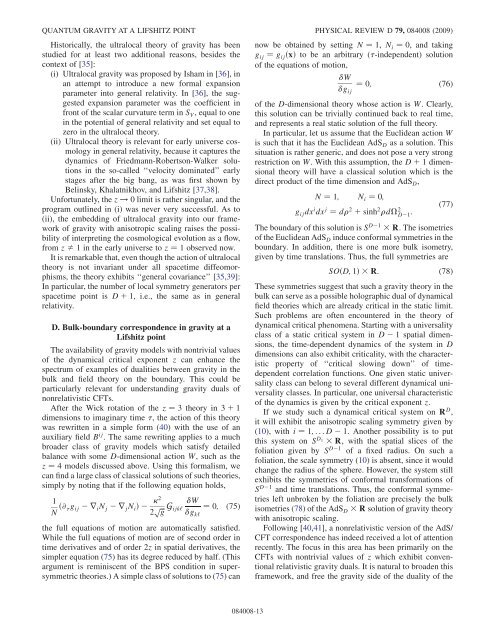Quantum gravity at a Lifshitz point
Quantum gravity at a Lifshitz point
Quantum gravity at a Lifshitz point
Create successful ePaper yourself
Turn your PDF publications into a flip-book with our unique Google optimized e-Paper software.
1N ð@ 2g ij r i N j r j N i Þ2 ffiffiffi Wp Gg ijk‘ ¼ 0; (75)g k‘the full equ<strong>at</strong>ions of motion are autom<strong>at</strong>ically s<strong>at</strong>isfied.While the full equ<strong>at</strong>ions of motion are of second order intime deriv<strong>at</strong>ives and of order 2z in sp<strong>at</strong>ial deriv<strong>at</strong>ives, thesimpler equ<strong>at</strong>ion (75) has its degree reduced by half. (Thisargument is reminiscent of the BPS condition in supersymmetrictheories.) A simple class of solutions to (75) canQUANTUM GRAVITY AT A LIFSHITZ POINT PHYSICAL REVIEW D 79, 084008 (2009)Historically, the ultralocal theory of <strong>gravity</strong> has beenstudied for <strong>at</strong> least two additional reasons, besides thecontext of [35]:now be obtained by setting N ¼ 1, N i ¼ 0, and takingg ij ¼ g ij ðxÞ to be an arbitrary (-independent) solutionof the equ<strong>at</strong>ions of motion,(i) Ultralocal <strong>gravity</strong> was proposed by Isham in [36], inWan <strong>at</strong>tempt to introduce a new formal expansion¼ 0;gparameter into general rel<strong>at</strong>ivity. In [36], the suggestedij(76)expansion parameter was the coefficient infront of the scalar curv<strong>at</strong>ure term in S V , equal to onein the potential of general rel<strong>at</strong>ivity and set equal tozero in the ultralocal theory.of the D-dimensional theory whose action is W. Clearly,this solution can be trivially continued back to real time,and represents a real st<strong>at</strong>ic solution of the full theory.In particular, let us assume th<strong>at</strong> the Euclidean action W(ii) Ultralocal theory is relevant for early universe cosmologyin general rel<strong>at</strong>ivity, because it captures the situ<strong>at</strong>ion is r<strong>at</strong>her generic, and does not pose a very strongis such th<strong>at</strong> it has the Euclidean AdS D as a solution. Thisdynamics of Friedmann-Robertson-Walker solutionsin the so-called ‘‘velocity domin<strong>at</strong>ed’’ earlyrestriction on W. With this assumption, the D þ 1 dimensionaltheory will have a classical solution which is thestages after the big bang, as was first shown by direct product of the time dimension and AdS D ,Belinsky, Khal<strong>at</strong>nikhov, and <strong>Lifshitz</strong> [37,38].Unfortun<strong>at</strong>ely, the z ! 0 limit is r<strong>at</strong>her singular, and theN ¼ 1; N i ¼ 0;program outlined in (i) was never very successful. As tog ij dx i dx j ¼ d 2 þ sinh 2 d 2 D 1(ii), the embedding of ultralocal <strong>gravity</strong> into our framework(77)of <strong>gravity</strong> with anisotropic scaling raises the possi-The boundary of this solution is S D 1 R. The isometries:bility of interpreting the cosmological evolution as a flow,from z Þ 1 in the early universe to z ¼ 1 observed now.It is remarkable th<strong>at</strong>, even though the action of ultralocalof the Euclidean AdS D induce conformal symmetries in theboundary. In addition, there is one more bulk isometry,given by time transl<strong>at</strong>ions. Thus, the full symmetries aretheory is not invariant under all spacetime diffeomorphisms,the theory exhibits ‘‘general covariance’’ [35,39]:SOðD; 1ÞR: (78)In particular, the number of local symmetry gener<strong>at</strong>ors perspacetime <strong>point</strong> is D þ 1, i.e., the same as in generalrel<strong>at</strong>ivity.These symmetries suggest th<strong>at</strong> such a <strong>gravity</strong> theory in thebulk can serve as a possible holographic dual of dynamicalfield theories which are already critical in the st<strong>at</strong>ic limit.Such problems are often encountered in the theory ofD. Bulk-boundary correspondence in <strong>gravity</strong> <strong>at</strong> a dynamical critical phenomena. Starting with a universality<strong>Lifshitz</strong> <strong>point</strong>class of a st<strong>at</strong>ic critical system in D 1 sp<strong>at</strong>ial dimensions,the time-dependent dynamics of the system in DThe availability of <strong>gravity</strong> models with nontrivial valuesdimensions can also exhibit criticality, with the characteristicproperty of ‘‘critical slowing down’’ of time-of the dynamical critical exponent z can enhance thespectrum of examples of dualities between <strong>gravity</strong> in thedependent correl<strong>at</strong>ion functions. One given st<strong>at</strong>ic universalityclass can belong to several different dynamical uni-bulk and field theory on the boundary. This could beparticularly relevant for understanding <strong>gravity</strong> duals ofversality classes. In particular, one universal characteristicnonrel<strong>at</strong>ivistic CFTs.of the dynamics is given by the critical exponent z.After the Wick rot<strong>at</strong>ion of the z ¼ 3 theory in 3 þ 1If we study such a dynamical critical system on R D ,dimensions to imaginary time , the action of this theoryit will exhibit the anisotropic scaling symmetry given bywas rewritten in a simple form (40) with the use of anauxiliary field B ij (10), with i ¼ 1; ...D 1. Another possibility is to put. The same rewriting applies to a muchthis system on S D 1 R, with the sp<strong>at</strong>ial slices of thebroader class of <strong>gravity</strong> models which s<strong>at</strong>isfy detailedfoli<strong>at</strong>ion given by S D 1 of a fixed radius. On such abalance with some D-dimensional action W, such as thefoli<strong>at</strong>ion, the scale symmetry (10) is absent, since it wouldz ¼ 4 models discussed above. Using this formalism, wechange the radius of the sphere. However, the system stillcan find a large class of classical solutions of such theories,exhibits the symmetries of conformal transform<strong>at</strong>ions ofsimply by noting th<strong>at</strong> if the following equ<strong>at</strong>ion holds,S D 1 and time transl<strong>at</strong>ions. Thus, the conformal symmetriesleft unbroken by the foli<strong>at</strong>ion are precisely the bulkisometries (78) of the AdS D R solution of <strong>gravity</strong> theorywith anisotropic scaling.Following [40,41], a nonrel<strong>at</strong>ivistic version of the AdS/CFT correspondence has indeed received a lot of <strong>at</strong>tentionrecently. The focus in this area has been primarily on theCFTs with nontrivial values of z which exhibit conventionalrel<strong>at</strong>ivistic <strong>gravity</strong> duals. It is n<strong>at</strong>ural to broaden thisframework, and free the <strong>gravity</strong> side of the duality of the084008-13



![arXiv:1001.0993v1 [hep-ph] 6 Jan 2010](https://img.yumpu.com/51282177/1/190x245/arxiv10010993v1-hep-ph-6-jan-2010.jpg?quality=85)


![arXiv:1008.3907v2 [astro-ph.CO] 1 Nov 2011](https://img.yumpu.com/48909562/1/190x245/arxiv10083907v2-astro-phco-1-nov-2011.jpg?quality=85)







![arXiv:1002.4928v1 [gr-qc] 26 Feb 2010](https://img.yumpu.com/41209516/1/190x245/arxiv10024928v1-gr-qc-26-feb-2010.jpg?quality=85)
![arXiv:1206.2653v1 [astro-ph.CO] 12 Jun 2012](https://img.yumpu.com/39510078/1/190x245/arxiv12062653v1-astro-phco-12-jun-2012.jpg?quality=85)
